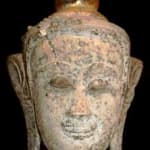Khmer Terracotta Head of Buddha, 13th Century CE
Terracotta
18.875
X.0238
The Khmer civilization, today embodied by the temples and ruins of Angkor, one of mankind's most astonishing and enduring architectural achievements and the largest religious monument in the world, flourished...
The Khmer civilization, today embodied by the temples and ruins of Angkor, one of mankind's most astonishing and enduring architectural achievements and the largest religious monument in the world, flourished from 802-1431 A.D. From the great citadel of Angkor, the kings of the Khmer empire ruled over a vast domain that reached from what is now southern Vietnam to Yunan, China and from Vietnam westward to the Bay of Bengal. The original city was built around the Phnom Bakeng, a temple on a hill symbolizing the mountain that stands in the center of the world according to Hindu cosmology. Successive kings enlarged the city, building other temples devoted to various Hindu deities and large reservoirs used for irrigation, which also symbolized the ocean surrounding the holy central mountain. The greatest of the Ângkôr temple complexes is Angkor Wat, constructed under King Suryavarman II (reigned 1113-1150) to celebrate the king as the incarnation of the god Vishnu.



